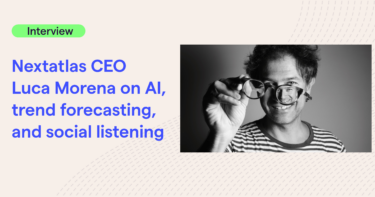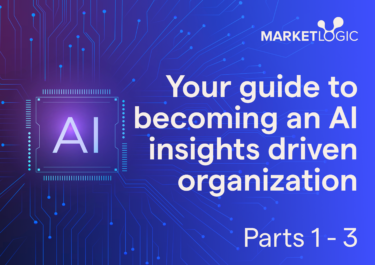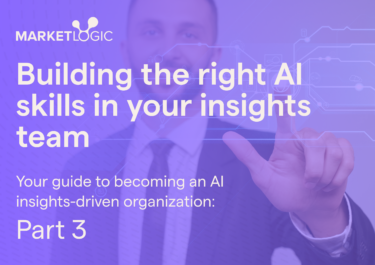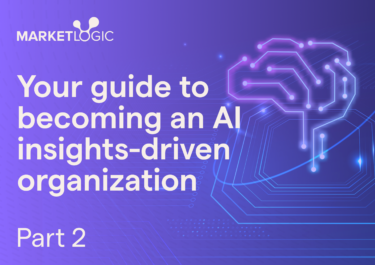
March 27, 2018
Read time: 8min

March 27, 2018
Read time: 8min
If you want to understand market research today, ask Sjoerd Koornstra. Formerly Global Consumer Market Insights (CMI) Planner at Heineken International, Sjoerd earned his expertise over three decades at the company, structuring and steering market research worldwide in the pursuit of excellence. Recognized by Market Logic Software as an innovation fellow for his contribution to the company’s research automation capabilities, Sjoerd brings to bear a broad, deep skillset in everything from data analytics to behavioral economics and applied neuroscience.
We caught up with Sjoerd to discuss his views on consumer and market insights, the role of technology, and the essential issues affecting the industry. What challenges do CMI organizations face? What can be done about them? And how do you create the insights that really count?
When research is at its best, a rapid insight leads to swift action with immediate market impact. That’s an ROI that all researchers strive for and only a few achieve. Sometimes the most powerful results are those that prevent top-line damage, rather than drive revenue growth. While working with Amstel in 2009, Sjoerd and his team delivered a decisive business outcome in exactly those circumstances.
“We were in South Africa, and there was a possibility that Amstel beer could not be produced locally,” says Sjoerd. “Instead, the company planned to import the beer from Europe. In this particular market, Amstel had always come in sealed plastic six-packs, but the brewery in Europe could only produce cardboard. So we ran a test.”
The problems began with a consumer journey in the most literal sense, as Sjoerd explains. “Consumers in townships would typically buy four six-packs at a time, then carry them home two in each hand. Then they would put them in a bucket of water to cool off until the evening. The cardboard six-packs would tear when carried, and fell apart when wet. They were a no-go for these consumers, who really needed plastic, sealed six-packs. I presented our results to the president of the region, who phoned the brewery manager straight away, telling them to order the equipment to produce plastic packs.”
This piece of research averted catastrophe for Amstel, displaying speed and efficiency all along the line from insight to action. It’s a perfect example of how the right insight, delivered fast can make the difference between success and failure. But it’s remarkable because it’s so unusual. What’s standing in the way of that performance elsewhere?
Sjoerd singles out two broad trends in business thinking that pull CMI in different directions: “On the one hand, there is a tendency towards being consumer-centric. On the other, businesses look to be lean and mean with a focus on their working commercial spend. By implication, research departments are under pressure.”
CMOs at companies using Market Logic split their marketing budgets evenly between a consumer-facing, media component – the working spend – and their internal, non-working spend. Many of their insights executives tell us they are working to move toward a 90:10 ratio in favor of the working spend.
It’s an uncomfortable fact: not only is research not considered a direct working investment, it faces severe cuts.
“The importance of research fluctuates in companies, like waves,” says Sjoerd. “Nowadays it is about agile, lean and mean working, but it was about that 20 years ago, too. Some aspects of lowering the non-working spend are easier to address than others. A big part of that budget is put into creating materials, so departments can save by sharing those between markets.”
Being lean and mean may be nothing new, but, Sjoerd believes, consumer-centric approaches really are an innovation. “Compared with 25 years ago, companies have a much more consumer-centric approach. Because of globalization and centralization, there are fewer players fighting with each other in several categories. The playground is getting smaller. You have to be innovative to gain an advantage. And with consumer-centric management approaches on the increase, there is an acknowledgment that insights are needed to do that.”
Recent BCG studies found that in 2009 only 43% of managers believed that consumer insight delivers an ROI at all. By 2015 that number was 68%. Yet the positive trend conceals an awkward reality.
“A lot of people think that consumer insights are delivering value,” continues Sjoerd. “But the truth is, that doesn’t always happen. Many people in market research came from research agencies and made the switch to companies later in their careers. They come from a world where more projects mean more turnover for their agency. But in companies, we deal with business issues. We need certain, specific kinds of information to make decisions.”
That culture clash causes concrete problems. “One of the problems I often see in companies is market researchers creating bottlenecks by commissioning projects,” says Sjoerd. “Their primary motivation should be to develop good data infrastructure. Excellent insight management systems make us much more efficient.”
At Heineken, Sjoerd implemented CMI Fresh (“Find Research Easily, Share Heavily”) a Market Logic platform that his team used to create sharp insights while making real, bottom-line efficiency savings. In conversation, he shared some of the ways smart infrastructure really made a difference. Here are our four key takeaways:
Every research project begins with a brief, and every project manager is familiar with the sheer time suck of finding the best practice briefing template for the task and sending multiple research briefs to different suppliers. By using automatic templates for all of their research briefs, project managers at Heineken issue one request for quotations to all vendors at once, meaning managers save time and responses come in faster.
“Before we started with the CMI Fresh platform, it was unclear to managers what our best practices for briefings really were,” says Sjoerd. “People were spending a lot of time reinventing the same briefing. At the same time, there was no common platform available for sharing tools, such as link tests. Communication was going on via email or on the shared drive, where people would find and adjust the latest deck, so we had different versions next to each other. By automating briefings in CMI Fresh, we save a lot of time with standardized briefings, and we share the latest tools, which are always up-to-date. There’s no longer any doubt about having the right version.”
Saving time at the beginning of the process is only one part of the story. Irregularities in briefings and approaches cause major headaches further down the line. That means standardization is key.
“Every year, Heineken ran the same taste test across its markets, to compare new flavors and new beers,” says Sjoerd. “Sometimes, in some markets, new CMI people entered the company and were unaware that there was a standard approach, even for the global brand. They might run their local study with a completely different approach, or waste time inventing a new method.
We had to ask about that, discuss what they had done, and try to work out which years of tests were even usable anymore. You had to evaluate what could really be done with this research that the company had spent money on.”
Standardized briefings mean standardized results that Heineken can compare with confidence. That has an enormous impact, highlighting synergies across markets that would otherwise be unclear. When Heineken set up a new innovation protocol with a standardized research method, thousands of small projects worldwide could be evaluated against the same KPIs.
The same principle applies to results and performance reporting, as well as methods and briefings. “A new global CMO joined our company from P&G, one of the most standardized companies in the world,” says Sjoerd. “Of course, he wanted to understand how brands were performing in markets, so he travelled the world meeting senior executive teams – the general manager, the marketing lead, the head of CMI. It drove him crazy that executives were using different methods to report the same information, even in the same market. Meetings were wasted comparing different kinds of numbers, trying to align with the right metric and its meaning.”
Sjoerd decided to drive forward standardization of brand-health tracking and campaign performance methods, both by aligning metrics for protocols and by appointing a global supplier. “When you use one supplier across 60 or 70 countries, it gives everyone a common interest in using the same methods and metrics, not only to compare results but to drive operational efficiency.”
It’s a structural change that makes it easier to implement best practices, as Sjoerd explains: “You’d have to invest tremendous time and effort to achieve the same alignment with competing suppliers.”
Standardized reporting also helps combat a common, if complex problem among managers: the tendency to cherry-pick data. Previously, marketers preparing reports might promote positive numbers from a campaign evaluation over weaker figures from brand-health performance for the same period.
To stop bad news from being hidden, Sjoerd designed the new reporting system to present absolute numbers or deltas from the same metrics, for clearer reports and more honest reporting.
There are reasons why knowledge management portals die. One of them is that research managers have to make time to upload new results, but with ten to fifteen research projects a year, by the time one project finishes you’re hard at work on the next. There’s no immediate benefit for a CMI manager to invest the time to summarize and upload the results.
For Sjoerd, one of the best aspects of the CMI Fresh platform is that it puts the responsibility for uploading results squarely with the supplier. Unlike CMI managers, research suppliers have an immediate business interest in uploading their results to the platform, where more people will see it, like it, share it, and comment on it.
Because the insights platform also accredits the supplier for their competencies, a publication is a great way to promote capabilities to the research team. That dynamic doesn’t just keep the platform alive, it makes it thrive.
Shifting the burden of uploading results onto suppliers also frees up time for Heineken staff, with an immediate impact on the non-working spend. “Instead of CMI managers uploading summaries, documents, and findings themselves,” says Sjoerd. “We provided CMI Fresh access to more than 400 supplier managers, saving an estimated €500,000 a year.”
For a company the size of Heineken International, developing platforms is a massive undertaking, involving a global research agency running a major deep dive into multiple markets worldwide. It was an area where Heineken leveraged CMI Fresh for efficiencies at scale.
“We gave the agency temporary access to CMI Fresh, to see all the quantitative and qualitative studies they had not executed themselves,” says Sjoerd. “By reusing the knowledge already available and making deductions from it, we saved a substantial amount of money.”
Pooling knowledge also means Heineken can confidently predict the ways different markets interact. “We compared similarities and differences between markets,” says Sjoerd, “then developed platforms based on that which we knew would resonate with consumers in different parts of the world.” A recent example of that is Heineken’s recent rollout of Radler, or shandy, a light combination of beer and lemonade.
“Radler has been a fantastic hit,” says Sjoerd. “We take local, mainstream brands and add lemon flavor. We began by testing the concept to see if it would resonate with consumers. The CMI Fresh system meant that after testing in five or six markets we could be confident that it would be a hit everywhere. We were sure it would have potential in every market. When you have standardized metrics, you can make that decision based on certain similarities between markets. So we stopped the concept testing in order to drive speed, and our main focus switched to taste testing, selecting the best lemon drink to match it with, ready for launch.”
Now Heineken is looking to deploy lessons from insight management elsewhere in the company by working on standardization across its platforms, so it’s easier to exchange material than it is to spend money making it twice.
For example, Sjoerd extended access to CMI Fresh to marketers, so they can get fast answers to their questions without creating extra work for researchers, saving a further €600,000 a year. It’s about doing more with less, showing the kind of resourceful thinking that makes a difference anywhere, whether in a company boardroom or the townships of South Africa.
For more wisdom from Sjoerd Koornstra, reach out to The House of Insights

How is AI transforming roles, skills and capabilities in insights functions?

Interview with Nextatlas CEO Luca Morena

An introduction to gen AI for businesses. From RAG to LLMs — get the lowdown.

Exploring the Future of AI in Marketing: Integrating Insights into Business Systems for Enhanced Decision-Making.

To succeed in today's dynamic consumer landscape, your organization must be able to react faster…

How does this guide help you? In part 3 of our guide, we’ll delve into…

Learn the AI insights-powered enterprise systems architecture and processes.

Transform your organization with insights. Download this guide to find out how.